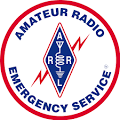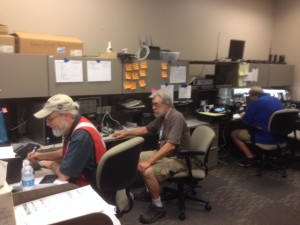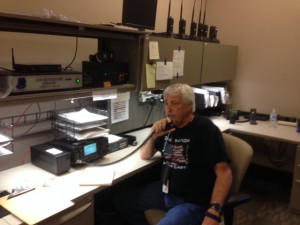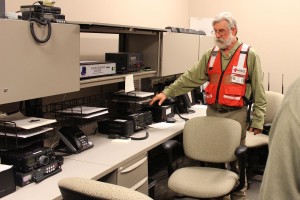LA ARES Region 2 Quarterly Meeting
The Louisiana ARES Region 2 held its 3rd quarterly meeting at the Capital Area Chapter of the American Red Cross on Tuesday, August 14, 2018. A report on the meeting is available here.
Louisiana ARES Region 2
Emergency Net Update
 Since November, 2016, reactivation, Region 2 ARES has held Sunday evening nets on the 146.790, PL 107.8 repeater at 8:00pm. Through the end of December, the net is averaging 15 check-ins. The net roster has 50 emergency amateur radio operators (AROs) listed. Of that number only 28 are listed with the Louisiana Section ARES group. You are encouraged to go to the Louisiana ARRL website, laarrl.org, and register. It is easy to do. There is no cost or mandatory public service requirements. What it does allow is a State or Section database to be available in the event of an incident to notify AROs needed. If you are checking into the nets, please register. Click on ARES at laarrl.org and, then, click on ARES REGISTRATION. While there, you may want to join Facebook or Google to get the latest Section information.
Since November, 2016, reactivation, Region 2 ARES has held Sunday evening nets on the 146.790, PL 107.8 repeater at 8:00pm. Through the end of December, the net is averaging 15 check-ins. The net roster has 50 emergency amateur radio operators (AROs) listed. Of that number only 28 are listed with the Louisiana Section ARES group. You are encouraged to go to the Louisiana ARRL website, laarrl.org, and register. It is easy to do. There is no cost or mandatory public service requirements. What it does allow is a State or Section database to be available in the event of an incident to notify AROs needed. If you are checking into the nets, please register. Click on ARES at laarrl.org and, then, click on ARES REGISTRATION. While there, you may want to join Facebook or Google to get the latest Section information.
Presently, the net is looking for a net controller for the 4th Sunday of the month. Currently, the Net Controls are:
- 1st Sunday: N5KHM – Daniel
- 2nd Sunday: KK5RH – Robin
- 3rd Sunday: KD5MLD – Mike
- 4th Sunday: OPEN
- 5th Sunday: W5CGX – Dave
Please contact Michael J. Nolan, KD5MLD, if you are interested in providing this amateur radio service for our community.
There is SkyWarn training scheduled on January 24, 2017, at the EBRP Main Library on 7711 Goodwood Blvd., Baton Rouge, LA 70808. The session is from 6:30pm to 8:30pm. You are encouraged to attend.
There will be a simulated exercise and test of our Region 2 response on Saturday, February 4, 2017. THIS IS A REGION 2 EXERCISE & TEST ONLY. An email will be sent prior to the the exercise followed by phone contact with information of the nature of the emergency and where to check-in. If you have a relationship with one of our “served agencies”, please let Mike know, as we will need to list you as a Liaison Station with that particular agency.
Introduction to Emergency Communication
 On Wednesday, 10.12.16, 22 amateur radio operators (AROs) participated in an Introductory Emergency Communication course in Baton Rouge. Sponsored by BRARC and coordinator by the Region 2 Planning Committee, five of the participants presented best practices utilizing the ARRL’s publication ARES Field Resources Manual as a guide for the emergency communicator. Overall, the course evaluation score was 4.5 on a scale of 1 to 5 with 5 being the highest. One suggestion included rotating future courses in different locations in the Region. Also suggested were topics that would cover SkyWarn, digi modalities, and speakers from various Served Agencies regarding their respective ARO credentialing requirements and processes. Below this update, there is a handout attached from Gerard Ducote, W5TZX, as requested from the course participants. It gives a very good perspective of what the government agencies are requesting from AROs prior to being deployed. If you have additional questions, contact Gerard.
On Wednesday, 10.12.16, 22 amateur radio operators (AROs) participated in an Introductory Emergency Communication course in Baton Rouge. Sponsored by BRARC and coordinator by the Region 2 Planning Committee, five of the participants presented best practices utilizing the ARRL’s publication ARES Field Resources Manual as a guide for the emergency communicator. Overall, the course evaluation score was 4.5 on a scale of 1 to 5 with 5 being the highest. One suggestion included rotating future courses in different locations in the Region. Also suggested were topics that would cover SkyWarn, digi modalities, and speakers from various Served Agencies regarding their respective ARO credentialing requirements and processes. Below this update, there is a handout attached from Gerard Ducote, W5TZX, as requested from the course participants. It gives a very good perspective of what the government agencies are requesting from AROs prior to being deployed. If you have additional questions, contact Gerard.
The LA Section ARES Simulated Exercise Testing (SET) will be held Saturday morning, 10.22.16. ARES members as well as amateur radio clubs in Region 2 will be notified of the SET by email with follow up phone calls to individual ARES Region 2 members listed on the Region 2 database. Region 2 is setting up a phone tree to followup on initial emails during any & all activation. LA Section ARES, our State leadership, will be posting information via their Facebook and Google accounts as well. If you have not enrolled online into the LA Section ARES database, please do so immediately as well as the Facebook and Google accounts. Go to the ARRL Louisiana Section website, click on ARES and, on the next page on the left, select ARES Registration. Register as “a new member” as the system has been purged and is being updated this year. Then go back to the home page and click on the Links and scroll down to the Facebook and Google accounts and click. You will get all the latest information from LA Section ARES leadership.
Region 2 will be kicking off its ARES Net on Sunday, 11.06.16, at 20:00 CST, on the 146.790 (-) FM repeater, 107.2 PL. It will be a roll call by groups beginning with the 1st letter in the suffix of your call sign. We are in need of net controllers for either the 2nd, 4th, or 5th Sunday of the month. This is a great way to practice running nets and networking with your fellow AROs prior to an emergency. For more information, please contact Michael J. Nolan.
Michael J. Nolan, KD5MLD
 An Invitation to Members of the BRARC,
An Invitation to Members of the BRARC,
a Special Service Club of the ARRL
Why should I join ARES? Because it is an important service to your community. Why should you join? Because each one of us as an active member of our club has special gifts and talents and a willingness to share. ARES is great way to serve your neighbors during communication emergencies. General Honore indicated that one of the top key components in an responsive emergency plan is communication. ARES serves that mission with its partnered agencies, such as FEMA, Red Cross, RACES, and many of the faith based groups.
There is no additional cost to apply to be a member, no binding commitment if you cannot serve, and it is easy to register by going online to the http://www.laarrl.org website. Once there, click on ARES at the top. Scroll down to ARES REGISTRATION and click. Complete the form and hit the submit button. If you need training, the ARRL & FEMA courses are online. I will be glad to assist you with the training and answer any additional questions. Thank you for your consideration and all that you do for amateur radio.
Michael J. Nolan, KD5MLD (formerly WA5JSK)
Amateur Radio Operators Assist the American Red Cross
By Steve Irving, WA5FKF

Dana Browne AD5VC (left) and Steve Irving WA5FKF (center) handling shelter requests in the Red Cross Comm Room
Amateur Radio Operators were called by the American Red Cross to provide backup communications during the recent flooding in South-central and Southeastern Louisiana beginning August 11th. With cell phone coverage diminished because of a flooded switch station, Steve Irving, the Disaster Services Technology (DST) lead for the Red Cross in LA, activated the local DST Amateur Radio operators. Soon after activation, the entire AT&T communications system failed in the affected area, which required more communication help. Irving then requested activation of the Amateur Radio Emergency Service (ARES) to support Red Cross shelter communications.
ARES is a corps of trained emergency radio operators maintained by the American Radio Relay League (ARRL), the national organization of Amateur Radio operators. The request was made to Adam Tamplain, the Louisiana Section Emergency Coordinator for ARRL. “Trained operators were vital to a successful response”, Irving said. Most of the DST volunteers had been through the Red Cross training including intensive training on Red Cross equipment. ARES also trains their volunteers and many of the Amateur Radio operators have had prior disaster experience. Forty Amateur Radio operators, including Red Cross DST and several ARES groups, participated in the effort. The week-long activation included operators from Alabama, as well as Arkansas and Mississippi. American Red Cross DST Amateur Radio operators came from as far as Ohio, Florida, Texas, and Arkansas to support the operation.

Gary Alberstadt KA3FZO, checking in with the National Hurricane Center on the movement of Tropical Storm Hermine
Several Baton Rouge area Amateur Radio operators spent lengthy shifts operating the Red Cross Communications Room as well as deploying to several shelters to provide needed communications support. Amateur Radio operator Jennifer Bordelon provided communications at the Celtic Shelter in the early days of the disaster. Operator Dan Lott was on duty during the early hours of August 14th, when the shelter he was at on Flannery Road in BR began to flood. He notified the Red Cross DOC using Amateur Radio of the flooding so a new shelter could be arranged, with cots and supplies delivered.
With local and parish resources stretched to the limit, Amateur Radio volunteers served as the communication link between the Red Cross shelters and command centers, relaying vital information on the needs of each shelter back to the Red Cross offices.
Communications Room at the American Red Cross
Steve Irving, WA5FKF and Disaster Services Technology Coordinator for Louisiana, is showing off the Emergency Comm Room in the Disaster Operations Center at the American Red Cross building in Baton Rouge. The equipment consists of an Icom D-Star ID800H, Yaesu FT-897, Icom IC 746 Pro, Yaesu FT-8800R, and a Motorola XLT 2500 connected to the State EOC. The station operates KE5QJQ, an open repeater on 444.950 MHz, 107.2 PL. A low band 47.42 MHz simplex system is used for Red Cross communications with the ERVs in the field. Various antennas are mounted on the adjacent 100 ft. tower. In a time of disaster, Red Cross Amateur Radio operators, assisted by local Ham Radio operators will operate the radios to provide Disaster Assessment Teams and Shelters with necessary communications.
New Memorandum of Understanding Between ARRL and Red Cross
 ARRL and the American Red Cross have signed a new Memorandum of Understanding. The document will remain in place for the next 5 years. The memorandum details the relationship of Amateur Radio Emergency Service (ARES) and the Red Cross during emergencies.
ARRL and the American Red Cross have signed a new Memorandum of Understanding. The document will remain in place for the next 5 years. The memorandum details the relationship of Amateur Radio Emergency Service (ARES) and the Red Cross during emergencies.
The complete ARRL news release is available here. The new ARRL/Red Cross MOU signed in January can be viewed here.
Scott Wren (KD5DLF) the incoming ARRL Louisiana section manager, will be present at our February 23rd monthly meeting. Come and meet Scott. He will make a brief presentation and be available for questions. Scott is also the current Louisiana Section Emergency Coordinator. The program will be given by Steve (WA5FKF) and will focus on Red Cross disaster assessment.
Since 1913, public service communication has traditionally been one of the primary responsibilities of the Amateur Radio Service. Today, disaster work is highly organized with amateur radio operators regularly participating with State and local offices of Emergency Management as well as Disaster Relief organizations. Each year amateur radio operators donate hundreds of man hours to their communities for public service events and in response to emergencies. BRARC has a proud tradition of public service since our organization in 1937.
Amateur Radio Operators have responded to many disasters in the past, but Hurricane Katrina proved to be the largest communications disruption in history. Stranded people were unable to contact 911 in many areas. The phone company switch was underwater preventing any incoming calls; the network depended on the local switch to route calls; however, some people were able to call long distance to find help. Upon reaching a friend or family member, they would advise their location and then ask that party to call their local 911 or attempt to reach someone in Louisiana.
With the assistance of Amateur Radio operators, State EOC was able to maintain contact with New Orleans using a series of linked repeaters. Hospitals were able to coordinate the delivery of supplies and many rescue calls were received on amateur radio and then routed to the Coast Guard. The Hammond Club provided use of their repeater; allowing the State EOC to communicate directly with Washington Parish. Amateur radio was the only reliable method of communication with the parish. This link was used by several state and parish officials to coordinate delivery of emergency supplies and to assist in the evacuation of hospitals and nursing homes in the area.
Locally, several BRARC members assisted the Salvation Army at their local command center and with the distribution of relief supplies.
After the storm many people realized that amateur radio still had value. In 2006, a White House Report on Katrina recognized that Amateur Radio for its role in rescue and recover. Many new stories followed; here are a few of the notable quotes that have appeared in news reports after the storm….
When we’re moving through the neighborhoods, we need to communicate with police and other authorities. All of us have these different radios,” said Klooster. “The technology that we have has not been implemented to share information across these boundaries.
Army Col. Larry Klooster
CIO -Joint Task Force Katrina
Government Computer News 9/13/05
…the radio communications system for the New Orleans police and fire departments dissolved as its radio towers lost their backup power generators in the ensuing flood. Some of the equipment could have been brought back up quickly, except that technicians were blocked from entering the submerged city for three days by state troopers who were themselves struggling with an overwhelmed radio system from a different manufacturer.
AP 9/13/05
Our communications grid was devastated and we need significant assistance in restoring governmental communications,
Louisiana Governor Kathleen Blanco
9/2/05 in a Letter to President Bush
As has been proven consistently and repeatedly in the past, when communications systems fail due to a wide-area or localized natural disaster, Amateur Radio works, right away, all the time…
Jim Hayne
ARRL 9/15/05
As usual, throughout the stricken areas, ham radio operators have been pressed into service. When telephone systems fail, and cell towers and their circuits collapse under the load, there’s nothing like good old-fashioned Amateur Radio…
The Ocala Star-Banner
9/9/05
Ham operators have also helped locate the stranded in New Orleans. Although many in need of rescue there had cell phones, once the storm hit they were able to reach the authorities only by calling people outside the area, because the land lines on which 911 calls within the city depended had been destroyed.
New York Times
9/8/05


